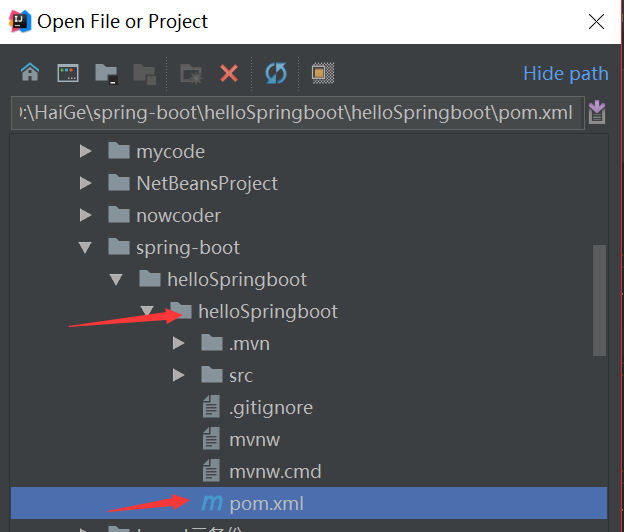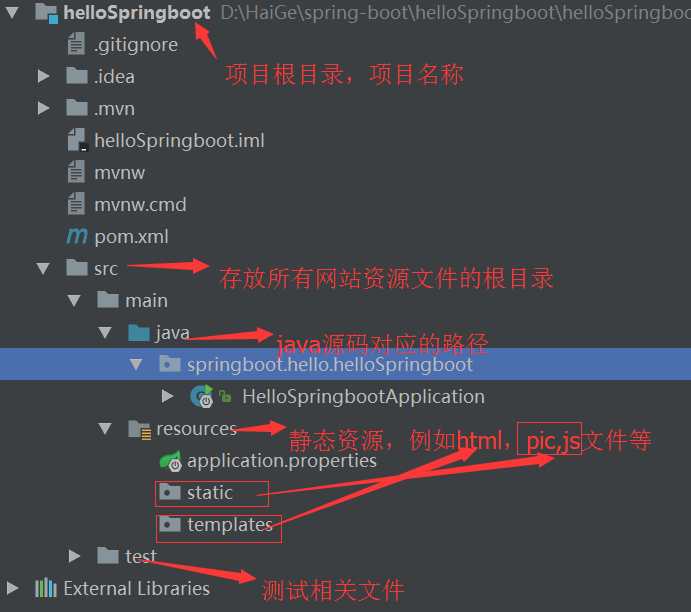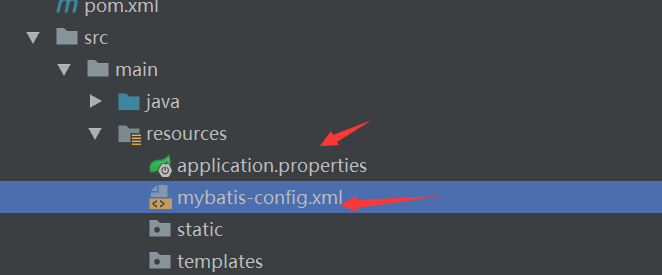Spring-Boot快速搭建web專案全解
Spring-Boot快速搭建web專案
最近在學習Spring Boot 相關的技術,剛接觸就有種相見恨晚的感覺,因為用spring boot進行專案的搭建是在太方便了,我們往往只需要很簡單的幾步,便可完成一個spring MVC專案的搭建,感覺就是下圖:

好,下面就本人搭建專案的過程簡單說說如何快速搭建一個spring MVC專案,相信我,spring-boot這趟車,你上了根本就停不下來了!
下面是這篇部落格的主要內容:
1、spring boot 介紹
2、spring boot 專案快速搭建
3、spring-boot中單元測試
4、spring boot 與mybatis 的整合
一、初識spring boot
1、web專案傳統的搭建方式
匯入jar包,配置tomcat 的context.xml 、web.xml,配置class path ,啟動。我靠,怎麼一堆報錯?classNotFoundException?尼瑪哥不是匯入了jar包嗎,哦版本不對,那我使用maven管理jar包咯,千辛萬苦終於配置好maven 並學會了如何使用,啟動也沒報錯了,但是尼瑪已經過去打半天了我都還沒有開始正式程式碼的書寫,趕緊開始寫業務程式碼吧,又發現spring 中配置老是尼瑪的報錯,而我他媽只是想要搞個簡單的發郵件功能啊。
所以說,自己搭建web專案,很多步驟都是重複性的,有沒有什麼工具可以一步達成啊?我只想快點投入到實際業務開發中去,我再也不想折騰jar包版本問題,再也不想折騰那繁瑣的配置過程(雖然這是一個很好的學習過程),那麼,spring boot 估計是老鐵你不二的選擇!
2、spring boot 是什麼?
什麼是spring boot?直接copy官網的介紹:

原諒我並不咋地的英文,官網說,spring boot 可以讓你以一種非常簡單的方式構建一個機遇Application 的spring 專案,而你索要做的僅僅是run 這個專案,spring boot 集成了主流的框架,我們構建專案大概只需要兩三分鐘,spring boot 專案,只需要很少的配置即可。
用了spring boot 後,你會發現,什麼配置問題,什麼jar包問題統統沒有了,你的生產效力會提高很多,因為,spring boot 已經幫你弄好了一個專案原型,你只需要在這個原型上新增自己的業務程式碼,自己的service 和dao就萬事大吉了!
spring boot 真的有那麼厲害?好,下面就開始進入正題,說說怎麼搭建利用spring boot搭建專案。
2、spring boot 專案快速搭建
1、快速搭建一個spring MVC專案
來開頭來個Hello World先吧,下面緊跟我的步伐,利用spring boot 快速搭建一個MVC專案
第一步,上官網,進行專案原始jar 包的選取,官網線上搭建地址如下:https://start.spring.io/,看圖:

特別說明下:在選擇你要的jar 包中,一般包括三部分:web部分--包含 了spring、springboot 等常用的web開發必須jar包;spring提供的工具類部分(devTool),這個用於熱部署效果;資料庫部分,spring boot自動可以幫你繼承各種資料庫框架,我這裡以mybatis 為演示例子,最後選完jar包的效果如下:

第二步、下載專案並匯入IDE,當然,需要版本管理工具的支援,這裡推薦IntelliJ IDEA 開發工具(它簡直就是web開發的標配!),具體看下面截圖:

解壓後得到專案檔案![]() ,然後,就可以開啟我們的IDE,這裡已我最愛的IntelliJ idea為例子
,然後,就可以開啟我們的IDE,這裡已我最愛的IntelliJ idea為例子
開啟idea,找到file-->open-->選擇專案的路徑,找打pom檔案-->以project 形式開啟


第三步、hello spring專案 大概長什麼樣子?開啟專案之後,maven 會載入必須的jar包,這段時間,你可以去喝杯香醇的龍井茶或者咖啡,當專案構建完成之後,你會看到下面這樣的典型maven目錄結構:

具體各個目錄放什麼,請參考截圖,這裡補充說明的是,HelloSpringbootApplication是整個專案的入口,我們啟動專案不再是啟動tomcat,而是執行這個類,這個類的main方法就是整個專案的main方法即執行入口,
第四步,寫hello demo了。新建一個package demo,然後新建一個類HelloSpringBoot,寫入以下程式碼
@RestController
public class HelloSpringBoot {
@RequestMapping(path = {"/helloSpringBoot"})
public String HelloSpring (){
System.out.println("hello spring boot");
return "hello spring boot";
}
}
我們先不解釋這個類裡面的東西,先配置並啟動網站,初步感受下spring boot的魔力:
在啟動網站前,由於spring boot 是預設自動註冊載入資料庫相關的類檔案的,所以為了不報錯,我們需要開啟資料庫並在resource目錄下的application.property中加入資料庫配置相關檔案,這裡以mysql為例子,配置檔案如下:
spring.datasource.url=jdbc:mysql://localhost:3306/wenda?useUnicode=true&characterEncoding=utf8&useSSL=false spring.datasource.username=root spring.datasource.password=root
配置檔案中各個欄位含義估計讀者也能看懂,後面會再具體說明。
當然,如果沒有安裝資料庫,讀者也可以在HelloSpringbootApplication 類中利用exclude屬性宣告不自動註冊載入資料庫相關檔案,具體參考下面的程式碼:
@SpringBootApplication(exclude={DataSourceAutoConfiguration.class,MybatisAutoConfiguration.class})//這裡的MybatisAutoConfiguration.class對應你的資料庫框架
public class HelloSpringbootApplication {
public static void main(String[] args) {
SpringApplication.run(HelloSpringbootApplication.class, args);
}
}
然後,我們所有的工作就完成了,可以啟動網站了,見證奇蹟的時候到了。
找到 HelloSpringbootApplication類,雙擊打卡,右擊滑鼠,run,然後專案就啟動了。

啟動網站之後,輸入http://localhost:8080/helloSpringBoot即可訪問對應的方法。瀏覽器以及idea後臺效果如圖


這裡簡單解釋下這個類裡面的東西的含義:
首先是@RestController這個註解:用過spring的大佬估計知道是什麼東西,當我們其他類要通過spring引用該類時,第一步就是要將該類註冊到spring中,@RestController就是相當於將這個類註冊到spring容器的意思當然,還有一種比較常用的就是@Controller,具體他們兩區別後面再討論吧。
然後就是@RequestMapping,通過設定這個註解裡面面的path屬性,就可以宣告相對於專案根路徑(localhost:8080)的訪問路徑。
2、spring boot 專案中利用springMVC實現傳參
上面的demo中的方法只是一個非常簡單的例項,在實際生產中, 我們的應用不可能這麼簡單的,前端還需要傳輸引數到後臺,所以,用spring boot 構造的專案中,又如何實現傳參呢?(感覺下面的都是在總結sprign MVC相關的內內容了,所以大神勿噴我脫離主題,因為感覺spring boot 如果單獨總結的話,貌似的確沒什麼好總結的,而且spring boot 天生就不可能和其他spring 元件分割)具體請參開下面程式碼例子:
@RestController
public class HelloSpringBoot {/**
* url傳參,訪問的路徑類似這樣:localhost:8080/getParamDemo1/1
* 方法體中的引數要在前面加註釋,@PathVariable,代表url中的引數
*/
@RequestMapping(path = {"/getParamDemo1/{id}"})
public String getParamDemo1 (@PathVariable("id") int userId){
System.out.println("get param " + userId);
return "success get param";
}
/**
* 當然,你也可以通過這種傳參方式:localhost:8080/getParamDemo?param1=1或者直接表單提交引數
* 當然,同時方法中引數宣告的註釋也要變成@RequestParam,代表請求引數,required屬性說明了引數是否是必須的
*/
@RequestMapping(path = {"/getParamDemo2"})
public String getParamDemo2 (@RequestParam(value="param1",required = false) int param){
System.out.println("get param " + param);
return "success get param";
}
}
3、構建restful程式設計風格
最近,resultful風格程式設計挺火的(雖然個人覺得不可盲目跟風),而spring boot中利用其內建的spring MVC等框架,可以非常簡單地實現這種程式設計風格。
例如說,我要請求查詢一個數據,在resultful類的程式設計風格中,查詢對應的是get請求,那麼,spring boot(準確說是spring MVC) 可以針對不同的請求進行處理,請看下面程式碼:
@RestController
public class HelloSpringBoot {
/**
* 通過設定RequestMapping的method屬性便可以設定該方法可處理的對應請求了,例如下面的getRequestDemo方法只會處理get請求
*/
@RequestMapping(path = {"/getRequestDemo"},method = RequestMethod.GET)
public String getRequestDemo (@RequestParam(value="param1",required = false) int param){
System.out.println("get request test ,get param " + param);
return "success get param";
}
/**
* 下面的deleteRequestDemo方法只會處理delete請求
*/
@RequestMapping(path = {"/deleteRequestDemo"},method = RequestMethod.DELETE)
public String deleteRequestDemo (@RequestParam(value="param1",required = false) int param){
System.out.println("delete request test ,get param " + param);
return "success get param";
}
}
另外,利用上面說的url中的值(類似這個:path="/member/{userid}")進行資源定位,也非常符合resultful的風格要求,例如這path="/getParamDemo1/{userid}"的配置就是對應的就是對會員級別的某個使用者(由userid定位)進行某些操作,如果要刪除該使用者,則對應http請求的delete請求即可。
通過上面的那些步驟,估計讀者對於如何用spring boot 進行一個簡單的web專案快速搭建已經清楚了,下面在spring boot搭建的專案中如何進行單元測試。
三、spring boot 專案中的單元測試問題
spring boot 中集成了junite框架,對於單元測試,也不用寫各種繁瑣的類了,只需要對測試類進行一定的註釋,spring boot 便會幫你做好一切,就算是資料庫相關的操作,spring boot 也能很好地進行測試,具體還是看程式碼例子,下面是一個簡單的測試業務類方法的例子:
首先,我們新建一個service 層,新增一個demo類,最後的demo程式碼如下:
@Component
public class ServiceDemo {
public String testDemo(){
String rtnAfterDosomething = "我是返回結果";
//這裡是業務程式碼
return rtnAfterDosomething;
}
}
下面的程式碼是測試類
@RunWith(SpringRunner.class)
@SpringBootTest
public class ServiceDemoTest {
@Autowired
ServiceDemo serviceDemo;
@Test
public void testDemo() {
String rtn = serviceDemo.testDemo();
Assert.assertEquals(rtn, "我是返回結果");
}
}
如果要測試資料庫dao,也是類似的,但是特別注意的是,測試之前必須啟動專案(即HelloSpringbootApplication的run方法必須執行起來),否則將會包can not find ApplicationContext的錯誤。
四、spring boot中配置資料庫框架(以mybatis為例子)
在spring boot中整合資料庫相關的開源框架也是很方便的(當然,記得在一開始新建專案的時候引用相關的jar包),當你上面的步驟都沒什麼錯誤的時候,你只需要簡單地配置下applocation.properties檔案即可
spring.datasource.url=jdbc:mysql://localhost:3306/springboot?useUnicode=true&characterEncoding=utf8&useSSL=false spring.datasource.username=root spring.datasource.password=root #下面這條配置聲明瞭mybatis的配置檔案路徑,classpath對應的是和這個檔案統計的resources mybatis.config-location=classpath:mybatis-config.xml
目錄的檔案結構參考下面截圖:

ok,mybatis 的引用配置便弄好了,下面我們嘗試利用mybatis 這個資料庫框架,進行一個數據庫的簡單查詢操作,首先,看下面的mybatis-config.xml的配置內容,讀者可以以這個為模板進行配置,當然,想了解更具體的mybatis配置說明,建議去官網看看,這裡不展開了:
<?xml version="1.0" encoding="UTF-8"?>
<!DOCTYPE configuration
PUBLIC "-//mybatis.org//DTD Config 3.0//EN"
"http://mybatis.org/dtd/mybatis-3-config.dtd">
<configuration>
<settings>
<!-- Globally enables or disables any caches configured in any mapper under this configuration -->
<setting name="cacheEnabled" value="true"/>
<!-- Sets the number of seconds the driver will wait for a response from the database -->
<setting name="defaultStatementTimeout" value="3000"/>
<!-- Enables automatic mapping from classic database column names A_COLUMN to camel case classic Java property names aColumn -->
<setting name="mapUnderscoreToCamelCase" value="true"/>
<!-- Allows JDBC support for generated keys. A compatible driver is required.
This setting forces generated keys to be used if set to true,
as some drivers deny compatibility but still work -->
<setting name="useGeneratedKeys" value="true"/>
</settings>
<!-- Continue going here -->
</configuration>
恩,然後,就可以進行資料庫的操作了,我簡單用mysql建了個名字為springboot的資料庫,在庫裡面建了一個簡單的demo表(具體怎麼建表那些不用我說了吧?實在沒有接觸過資料庫的同學,可以自行百度或者谷歌去咯),然後,dao程式碼如下:
@Mapper
public interface DemoDao {
@Select({"select demo_param from demo "})
String queryDemo();
}
注意,mybatis 的dao是一個介面,關於mybatis更多的內容,請讀者參開官方文件,這裡不展開了。
然後,就在原來的ServiceDemo類中呼叫一下吧,程式碼看下圖吧:
import org.springframework.beans.factory.annotation.Autowired;
import org.springframework.stereotype.Component;
import org.springframework.stereotype.Controller;
import springboot.hello.helloSpringboot.dao.DemoDao;
@Component
public class ServiceDemo {
@Autowired
DemoDao demoDao;
public String testDemo(){
String rtnAfterDosomething = "我是返回結果";
//這裡是業務程式碼
return rtnAfterDosomething;
}
public String queryDemo(){
return demoDao.queryDemo();
}
}
ok,簡單寫個測試類,出現小綠條,測試成功。
然後,所有專案原型的工作完成了,然後,我們就可以進行我們核心業務開發了,很快有沒有?很爽有木有?所以說,spring boot 搭建專案的確飛快,可以讓我們省去很多機械的前期操作,讀者們趕緊去探索下吧,spring boot ,你值得捅有!
OK,今天總結到這裡,這個專案的程式碼在gitHub上這個地址,需要的人自取:https://github.com/lcpandcode/helloSpringboot.git
最後說一遍,spring boot ,用得真他媽爽!趕緊來吧!
